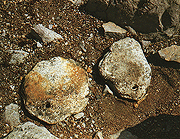On the island Dokos of the Saronic gulf, opposite the south coast of Hermionid, the most ancient shipwreck of the Aegean was studied by the Hellenic Institute of Maritime Archaeology (1989-1992). The submarine excavation research brought to light two stone anchors, large quantities of ceramics and many stone tools according to which the shipwreck dates to the Late EH II period (2450/2350-2200/2150). Parts of the ship have not been preserved. Some whole vases and thousands of shells which correspond to typical ceramic types of the Late EH II were found among the rich ceramic ship load. Beaked bowls and bowls with short spouts of the Urfirnis ware, basins, handled cups, amphoriskoi, amphoras, jugs (including a handle with an incised ship representation), sherds of three small closed vessels with painted decoration, a perforated neck of a closed vessel, brazier, spit supports, fragments of clay mobile hearths and a part of a Cycladic frying pan vessel. Apart from ceramics, the ship carried millstones, pestles, as well as obsidian blocks and blades from Melos. The egg-shaped and rectangular millstones (15 intact and 37 fragments), and the pestles (27 intact and 44 fragments) are made of volcanic materials (andesite, dacite), which come from the Saronic region (Aegina, Methana, Poros). The fact that millstones made of Aeginetan andesite were found in sites of the Argolid and Attica as well as that most of the millstones of Dokos had no traces of use reveal the commercial character of the ship and, apart from the trading of obsidian from Melos, they shed light on a more important aspect of marine trade in the Aegean of the Early Bronze Age. The existence of small coastal EH settlements on Dokos (Myti Kommeni and Ledeza) but also on the neighbouring small islands of the Argosaronikos gulf (e.g. Agia Marina on Spetses) must be connected to the need of intermediary stations which served trade from the Cyclades to the large EH centres of the Argolid (Tiryns, Lerna) and the Saronic gulf (Aegina). The ship that sank at Dokos probably took part in the marine trading network of the region which was served by small rowing boats.
|

|
|
|
The Dokos shipwreck.
|
||
 |
||
|
Stone anchors from the Dokos shipwreck. |
||